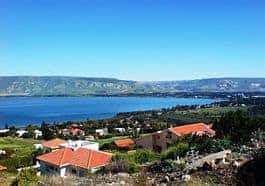 It’s hard to imagine what life must have been like for the young people who made aliyah on their own, long before the state of Israel was established. On our recent family trip, we visited the museum in Chatzar Kineret. Also known as Chavat Kinneret (Kinneret Farm), this was one of the earliest attempts at communal living and predated the nearby first kibbutz, Deganya.
It’s hard to imagine what life must have been like for the young people who made aliyah on their own, long before the state of Israel was established. On our recent family trip, we visited the museum in Chatzar Kineret. Also known as Chavat Kinneret (Kinneret Farm), this was one of the earliest attempts at communal living and predated the nearby first kibbutz, Deganya.
We paid a small entrance fee and added another two shekel each for a guide. The guide brought us into what would have been the farm’s original dining room, and showed us a painting of the area from around 1908. Then she asked the children to look out the window and notice what was different today. The answer: Trees and vegetation. We think of northern Israel as lush, with plentiful rain and lovely pines and palms. But when the first pioneers arrive, they found one lonely tree near the Kinneret (Sea of Galilee). The rest was a desert.
Originally founded by local farmers, the Kinneret farm was quickly populated by young male immigrants from the Second Aliyah. Aged 16-22, the guide explained that these were the hardcore Zionists. Most Jews who left eastern Europe at the time went to the US, while older olim settled in Haifa, Jerusalem, and the new Jewish city of Tel Aviv.
The young people worked in the fields from 4 am until 6 PM, then returned at night to learn Hebrew in the dining room. If you spoke a language other than Hebrew, you were ignored, even if you just came off the boat. Since they were also not allowed to complain out loud, the pioneers left a rich documentation of their experiences in diaries and letters.
Religiously, they wanted to retain their identity as Jewish, but adapt new traditions. Instead of a synagogue, they decided that the communal dining room should be the center of activity. They thought of new customs for the various holidays.
After a while women were lured to the moshava, with promises of equality. Instead, they were sent to work in the kitchen. But they had come from pampered families in Europe and couldn’t cook. When one of the women was left alone to look after the lentils, she didn’t know what to do when the pot started to boil over. No one had ever taught her about lowering the heat.
Eventually the women on the farm found a teacher and role model, Leah Meizel. An agronomist, she taught the women gardening and farming, and started an agricultural school for women.
The young pioneers had almost no older people to guide them. Rachel (Blubstein), one of Israel’s best-loved poets, lived on the Kinneret farm and later on nearby Kibbutz Deganya where she worked in the children’s quarters. When she got tuberculosis, no one was quite sure how to handle the situation. Eventually, she was asked to leave by one of the members. The museum played a movie recounting a letter she wrote shortly before she died. She describes her pain when no one said goodbye as she left the kibbutz. Most of her poems about the Kinneret were written after she left the kibbutz, and she was buried nearby.
Songwriter Naomi Shemer, the child of a pioneering couple, grew up on the neighboring Kevutzat Kinneret.
Hatishma Koli, performed by Hachalonot hagevohim, was written by Rachel.
You may also enjoy:
Free and Inexpensive Day Trips in Israel
We don’t live too far away and I took my kids to Tamar Bakfar at Moshava Kinneret as a summer vacation activity. Next time we speak ask me to tell you about the conversation we had with one of the offspring of the original settlers who is now an elderly gentleman.
This looks like a great museum. Thanks for letting us know about it.
it’s amazing the way the halutzim (kibbutznikim and non-kibbutznikim) lived and what they accomplished under those conditions.
great song. nasa used it to awaken the crew of columbia on the fourth day of its final flight. you can hear nasa speaking with crew at the end of the song here:
http://spaceflight.nasa.gov/gallery/audio/shuttle/sts-107/wave/fd04red.wav